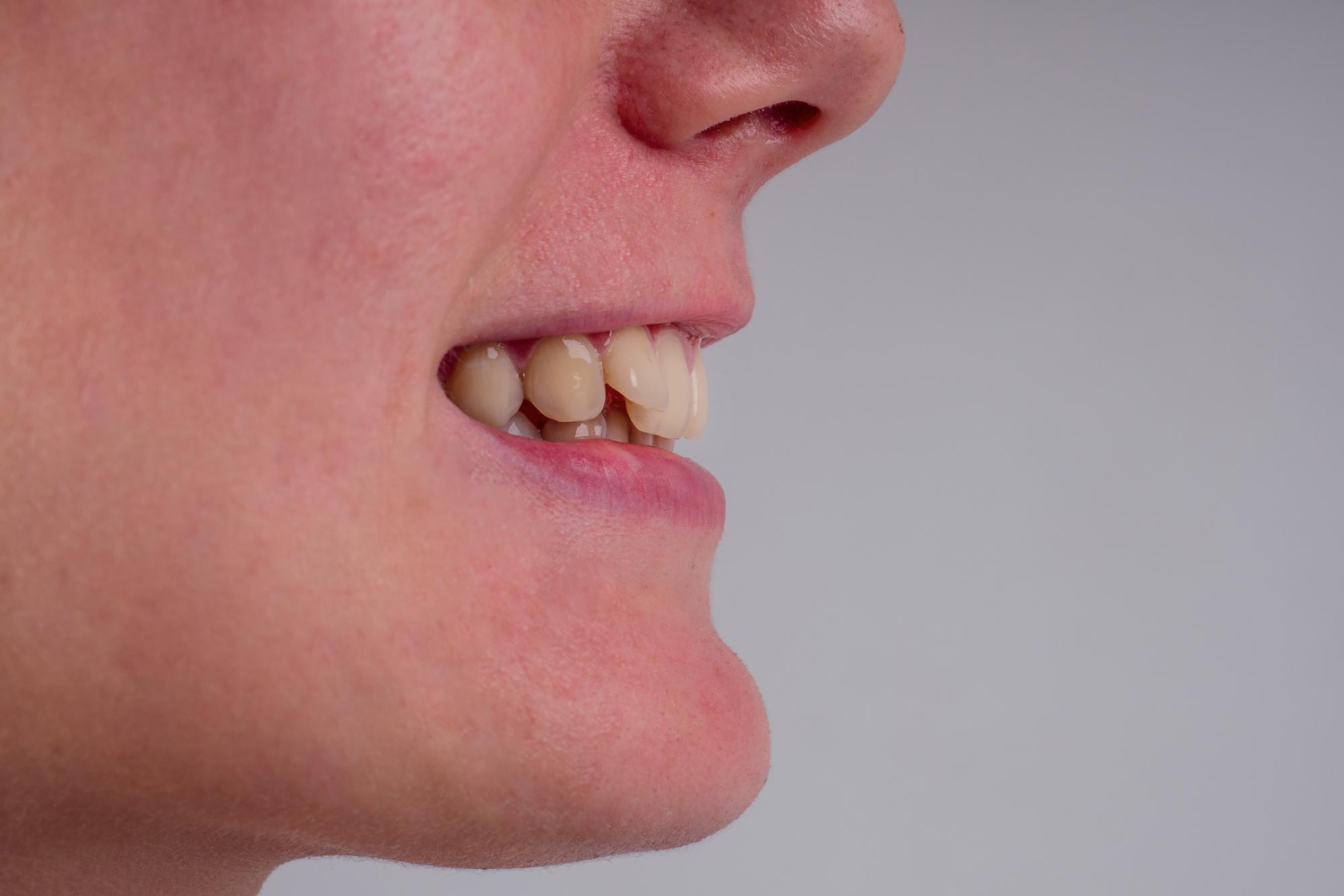Key Takeaways
- A deep bite happens when upper teeth overlap the lower ones excessively.
- It can lead to jaw pain, tooth wear, and facial imbalance.
- Treatments like braces and Invisalign can correct it effectively.
- Preventive care and early checkups help avoid complications.
- If you are in Fresno, visit Thurman Orthodontics for expert bite correction and a confident, healthy smile.
Ever looked at your smile and felt your upper teeth seem to hide your lower ones too much? That’s what is called a deep bite. It’s a common dental issue. Think of it as your teeth being out of sync, putting extra pressure on your bite every time you chew or talk.
The good news? Deep bite treatment is possible with the right orthodontic therapies and care. So, let’s take a deep look into the topic of deep bite teeth!
What is a Deep Bite?
A deep bite, sometimes called a deep overbite, occurs when your upper front teeth overlap the bottom ones more than they should. A slight overlap is normal. But a deep bite goes beyond that and may result in your lower teeth touching the roof of your mouth or the gums.
It is more visible when your mouth is closed. However, the deep bite issue affects more than simply appearance. A deep bite can adversely affect your oral health, from tooth wear to jaw pain.
What Causes a Deep Bite?
A deep bite typically develops gradually, often due to a combination of genetic factors, lifestyle habits, and growth patterns. Here’s a closer look at the most common causes:
-
Inherited Jaw Shape or Size
Genetics plays a major role. If your jaw is smaller or shorter than average, your upper teeth may naturally sit too far over your lower ones. Many people inherit this trait from their parents.
-
Missing or Worn Teeth
When teeth are missing or worn down from grinding (bruxism), your bite can collapse, causing the upper teeth to overclose the lower jaw.
-
Poor Oral Habits in Childhood
Habits like thumb-sucking, tongue thrusting, or prolonged pacifier use can push teeth out of alignment over time and deepen the bite.
-
Uneven Eruption of Teeth
Sometimes, the front teeth erupt too far down while the back teeth fail to rise properly. This imbalance leads to excessive vertical overlap.
-
Muscle Imbalance
Overactive jaw muscles can pull the teeth together tightly, maintaining a deeper bite even when the teeth are well aligned initially.
What are the Common Symptoms of a Deep Bite?
Deep bite teeth might not cause noticeable pain at first, but over time, they can lead to discomfort and visible changes in your smile. Here are some of the telltale signs:
-
1
Jaw Pain or TMJ Discomfort
Continuous strain from a misaligned bite can stress your jaw joints. This eventually leads to pain, clicking, or even headaches.
-
2
Tooth Wear and Chipping
Because the upper and lower teeth collide unevenly, enamel wears down faster, especially on the front teeth.
-
3
Gum Irritation or Injury
In severe cases, lower teeth can hit the upper gum line, causing irritation or cuts on the roof of your mouth.
-
4
A “Collapsed” Smile
A deep bite can make your lower face appear shorter, giving your smile a sunken or aged appearance.
-
5
Difficulty Chewing or Speaking Clearly
Misalignment can make it harder to bite into foods or pronounce certain words comfortably.
If you’ve noticed any of these symptoms, it’s worth scheduling a consultation with an orthodontist to assess your bite alignment.
Why is Treating a Deep Bite Important?
When your upper and lower teeth don’t meet properly, it puts extra pressure on your teeth, gums, and jaw joints. It can lead to gradual damage that often goes unnoticed until it becomes painful or visible.
Here’s what can happen if a deep bite is ignored:
- Tooth Damage: Constant friction between upper and lower teeth can lead to enamel wear, tooth sensitivity, and even chipping over time.
- Jaw Problems: The imbalance in your bite can strain jaw joints, causing discomfort, stiffness, or TMJ-related pain.
- Gum Recession: As the teeth overlap excessively, it can push on the gums and make them recede, increasing the risk of periodontal disease.
- Aging Facial Appearance: A deep bite can shorten the lower face and make the lips appear thinner, giving a prematurely aged look.
Treating a deep bite restores a balanced smile and helps improve chewing function. It reduces strain on your jaw and enhances your overall oral health and facial aesthetics.
How to Fix a Deep Bite?
Deep bites can be corrected effectively with modern orthodontic treatments. The right option depends on your age, bite severity, and oral health.
-
Braces
Traditional braces are effective for a deep bite. They gradually move your teeth and align the bite. They are particularly effective in severe or complex cases because they can adjust both the teeth and the bite depth.
-
Invisalign Clear Aligners
For mild to moderate deep bites, Invisalign is a discreet, removable option. The aligners gently move teeth into better alignment while also improving the way your upper and lower teeth meet.
-
Bite Plates or Functional Appliances
These specialized devices help open up the bite and retrain your jaw muscles. They are often used in growing children or teens.
-
Dental Restorations
If the deep bite is caused by worn-down or missing teeth, dental crowns or bridges may be used as deep bite orthodontic treatments to rebuild tooth height and restore balance.
-
Jaw Surgery (for Severe Cases)
In rare cases where the bite issue stems from skeletal discrepancies, corrective jaw surgery (orthognathic surgery) may be necessary.
Every treatment begins with a thorough bite analysis by your orthodontist to determine which approach fits best.
How Long Does it Take to Fix a Deep Bite?
The time it takes to correct a deep bite varies depending on how severe the case is and the treatment type you choose.
- Mild deep bites may be corrected within 6 to 12 months, often using Invisalign or limited braces.
- Moderate cases usually take 12 to 24 months, where both teeth and bite alignment are addressed gradually.
- Severe deep bites, especially those involving jaw misalignment, might take up to 2-3 years, particularly if surgical correction or restorations are required.
Your orthodontist gives you a personalized treatment plan after assessing your bite and jaw alignment. The most important thing is to follow through with your treatment instructions and retainers to ensure lasting results.
What Methods are Used for Preventing a Deep Bite in Adults?
Once your bite is corrected, keeping it that way is the key. Here’s how adults can prevent relapse:
-
Wear Your Retainers Consistently
After orthodontic treatment, retainers hold your teeth in place. Skipping them can cause your bite to shift again.
-
Address Bruxism (Teeth Grinding)
Grinding can wear down your teeth and cause your bite to deepen again. Night guards help protect your teeth while you sleep.
-
Maintain Regular Dental Visits
Routine check-ups allow your orthodontist to spot early changes and make adjustments before the bite worsens.
-
Replace Missing Teeth Promptly
Gaps left by missing teeth can change your bite pattern. So, replacements like implants or bridges should be placed quickly.
What Methods are Used for Preventing Deep Bite Teeth in Kids?
Early detection makes a huge difference. Parents can take simple steps to prevent a deep bite as their child’s teeth and jaws grow:
-
Encourage Healthy Oral Habits
Help your child stop thumb-sucking or pacifier use early to prevent unwanted pressure on the front teeth.
-
Schedule Early Orthodontic Screenings
The American Association of Orthodontists recommends the first check-up by age 7. This helps identify bite issues before they become severe.
-
Watch for Uneven Tooth Eruption
If you notice your child’s front teeth overlapping too much, don’t wait. Early treatment with functional appliances can prevent long-term complications.
-
Promote a Balanced Diet
Foods rich in calcium and proper chewing habits help with healthy jaw and tooth development.
Deep bite is a complex malocclusion with potential implications for both aesthetics and oral health. Early diagnosis and intervention are crucial to prevent or minimize the long-term consequences. A thorough evaluation by an experienced orthodontist or prosthodontist is essential to determine the most appropriate treatment plan, ensuring a functional, healthy, and aesthetically pleasing bite for years to come. Don’t hesitate to seek professional advice if you suspect you or your child may have a deep bite.
Ready to Discuss Your Deep Bite Treatment Options?
FAQs
-
Are overbite and deep bite the same?
Indeed, a deep bite is a form of overbite in which there is an excessive amount of vertical overlap between the upper and lower teeth.
-
Can a deep bite heal itself without medical intervention?
A deep bite frequently necessitates orthodontic or dental treatment since it does not self-correct.
-
When is the best time to treat a deep bite?
Although deep bite can be treated at nearly any age, the best results are sometimes obtained with early intervention in infancy or adolescence.
-
Does a deep bite hurt?
At first, it might not hurt, but with time, it may produce headaches, jaw pain, or other discomfort.
-
How much time does it take to treat deep bites?
With orthodontic appliances, treatment typically lasts between six months and two years. However, this duration varies based on severity.
-
Can speech issues be caused by deep bites?
Yes, occasionally, particularly if the bite has an impact on jaw mobility or tongue position.
-
Is deep bite treatment possible with clear aligners?
Yes, clear aligners can work, particularly for mild to moderate cases. However, braces or surgery may be necessary for more severe bite issues.
-
Will my face look better after getting rid of my deep bite?
Yes, it happens often. By restoring jaw balance and smile alignment, correcting a deep bite can improve the appearance of the face.
-
How much does it cost to treat a deep bite?
The treatment costs vary depending on the procedure:
- Braces: between $3,000 and $7,000
- Invisalign: between $3,500 and $8,000
- Surgery: It generally costs more as it is done for more complex cases
-
Can a deep bite recur after treatment?
Yes, if retainers are not worn as directed, relapse might happen. You can maintain the outcomes through routine dental appointments.
-
Is an overjet and a deep bite the same thing?
No, they are not the same. The term “overjet” describes the upper teeth’s horizontal projection over the lower teeth (think “buck teeth“). On the contrary, a vertical overlap is called a deep bite.
-
Can a kid outgrow a deep bite?
No, a deep bite is not something that most kids outgrow. In fact, if treatment is not received, it may get worse with age. Complications can be avoided with early orthodontic treatments.
-
How can retainers aid deep bite orthodontic treatment?
After Invisalign or braces, retainers keep the corrected bite in place. Without them, the deep bite may recur when teeth move back.
-
What distinguishes a normal bite from a deep bite?
The upper and lower front teeth overlap by roughly 20-30% in a typical bite. The overlap is severe with a deep bite, frequently encompassing over half of the bottom teeth.
Straighten Your Bite with Thurman Orthodontics!

Dr. Brian Thurman has spent his entire life enjoying all the beauty that California has to offer. A Fresno native, he still escapes to the ocean or the mountains whenever his busy schedule allows. Driven by his love for natural beauty, Dr. Thurman enjoys creating beautiful smiles and healthy bites that last a lifetime. He is proud to be the only Ivy League trained Orthodontist in the Fresno/Clovis area.

